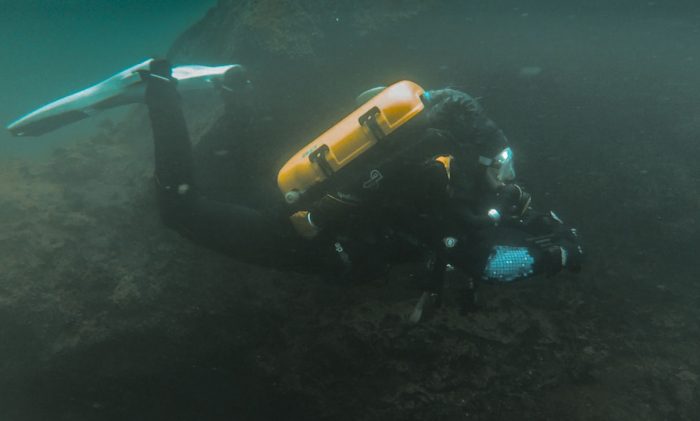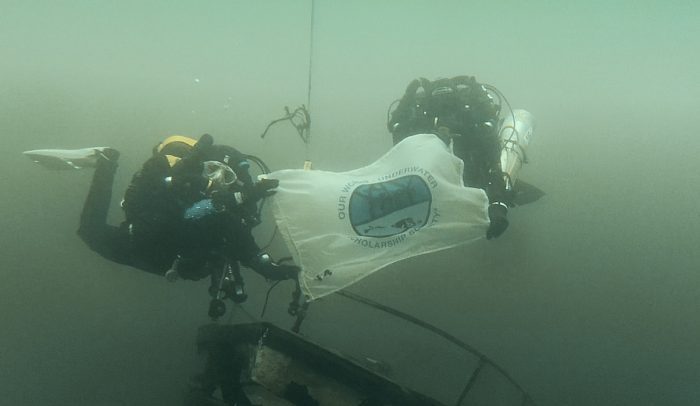Opening the delivery box, I’m faced with the yellow shell of a complex looking machine, the AP evolution rebreather unit. This was to be my first challenge of the scholarship, learning how to dive again.
The difference between closed circuit rebreathers and the more commonly used open circuit set up is that exhaled air in a rebreather system is recycled. Carbon dioxide is removed and a little bit of oxygen is added every so often to the “loop” to maintain the best mix of gas possible at any given depth. Bearing in mind I’ve never attempted any kind of technical diving before I was concerned that this may be out of my league.
Luckily, I had the guidance of Dive Tech legend, Mark Powell to help me understand this intimidating device. I’m not going to lie, I felt totally spoilt having such a renowned instructor all to myself for 4 days to complete the TDI CCR Air Diluent Course.
Did you know that Mark used to help develop satellites? I can see why he has such a respected reputation in the technical diving industry since as we moved between Chepstow Quarry and Vobster Quay, everyone knew Mark, and Mark knew them. In the water, he was super slick and it was like he invented trim.
I’ve never dived with someone who just seemed to appear here and there as it seemed like he never moved but was always one step ahead. Mark’s patience and thoroughness gave me confidence in my new endeavour of diving and will always remember the nuggets of advice he has given me.

It was during the pre-breathe, checking all components were in working order before the first dive with the unit that I started to become unnerved. It was a difficult balancing act trying to find the minimum volume of air in the loop. Minimum volume refers to the amount required in the loop for you to have a full breath without excess left over. Therefore, your breath that is recycled is either in your lungs or the counter lungs on the rebreather. I also had to wrangle with the bailout cylinder, a back up supply of air that you clip to your side. For the life of me, I couldn’t attach the cylinder to my back clip, which entertained Mark greatly. Evidently, I was quite apprehensive entering the water for the first time with the yellow box and preparing myself to breathe without any bubbles…
Entering the water, I exhale out of my nose to release gas from the loop to allow myself to break the surface tension of the water and descend. Hovering just underneath the blue side of the waterline I breathe in and out, no bubbles. It takes me a moment to soak in this strange experience.

Mark shows me the okay signal. I resist from sending him a huge smile back that would have broken the seal my lips form around the mouthpiece that prevent the release of air from the loop. So, I send the usual okay signal back… but I’m not just okay… I’m fantastic! Once I achieve minimum volume needed in the loop, additionally with a little bit of air in my drysuit, the buoyancy becomes effortless. Like a hoverfly, helicopter… a fish! Breathe in, breathe out… I haven’t moved an inch but stayed in the exact same depth. It felt like floating in the water column like an astronaut drifting in the vacuum of outer space. Gravity no longer had a hold on me and it was like being in flight, ambient pressure diving.
It wasn’t all easy though. When we were just pondering around the quarry I was fine with the unit and felt completely comfortable. However, once Mark started to introduce emergency scenarios I became a flailing mess. Mark would show me a card with a situation on, and I had to react with the correct protocol… at first my mind would go blank… hypoxia? Ummmm…. You do…. This?! I would then attempt the drill but somehow whilst conducting it I would always end up with my head in between some quarry rocks and my bum in the air, must have been a sight to see. I was determined to become slick and nail these drills for my own piece of mind. After this course I would be qualified to go away with my rebreather, ever so kindly loaned from AP diving (massive thank you to Nicky!), and explore the seas. I needed to be confident in my ability with handling the unit. Eventually, after lots of practice I’m happy to be let loose with the unit.
But where to take this new form of diving? Due to the mechanics of the rebreather there isn’t a build up of nitrogen in your system to the same extent as open circuit, which enables the diver to have a much longer dive. No complaints here! Not only that, since there are no bubbles you can get closer to wildlife without scaring them away, which is an invaluable tool in scientific diving and documenting wildlife. It’s no surprise that rebreathers are therefore becoming a big thing in scientific diving and I cannot wait to build up more experience with the unit and take it on a scientific expedition!
It’s safe to say that I’m converted. With a huge thanks again to Mark, his wife Kate and their cats, TDI, AP diving, Fourth element, Suunto, Rolex and of course OWUSS I can only imagine the opportunities that are on the horizon with this new and massive step in my diving career.
